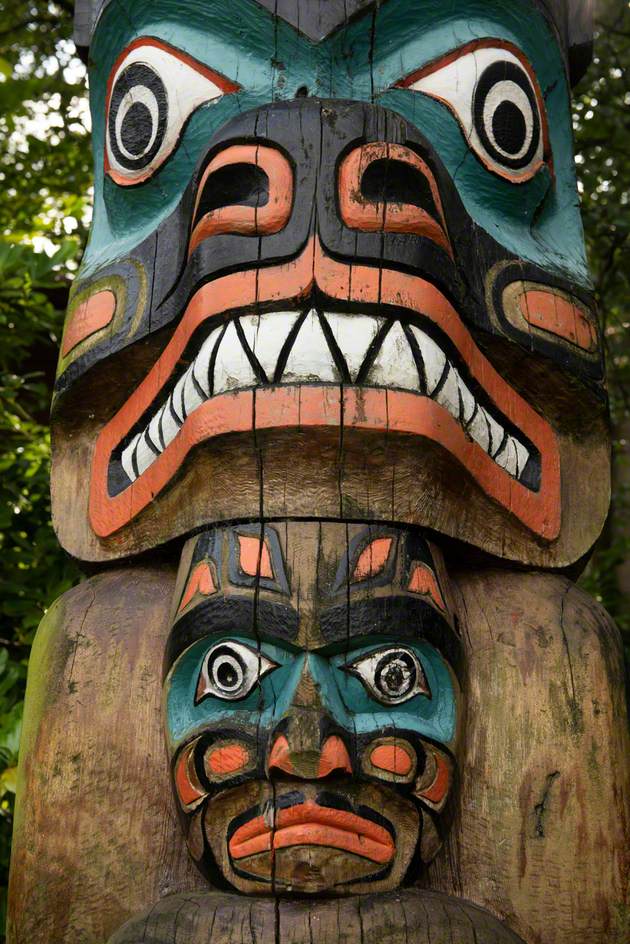
Personal Totem Poles Clay Totem pole art, Totem pole, Pole art
According to Steve Benson, totem carver and president of the Wood Age, a 20-foot pole can take four to six weeks to make. The process takes even longer if the pole is carved without power tools or chainsaws, as so many of the authentic totems are. Because totem poles are wooden, they're organic works of art.

Pacific NW Native American totem pole Pacific Northwest Art, Pacific Nw, Northwest Coast
There are certain elements that represent the unifying symbolism of various animals and legends which I follow through the knowledge and teachings of my Chiefs, Elders and artists. kwakwakwa'wakw fine Northwest Coast art by Kwakiutl artist, Calvin Hunt. Internationally renown for totem poles and masks.

TOTEM POLE BY GITSKAN NATION ARTIST RUPERT JEFFREY
Totem Pole History. Coast Salish artists did not carve tall wooden heraldic poles, known as totem poles, until the early 20th century. In earlier times, interior house posts were sometimes carved with human figures and other "spirit helpers" or abstract images referring to the spirit power belonging to the owners of the house. These were.

Totem Pole Art UK
Carved mostly from Western Red Cedar trees, totem poles are created by the Indigenous peoples of the Pacific Northwest Coast of North America. Because cedar decomposes quickly, few examples of these massive structures from before 1900 exist today. These free-standing poles were symbols of individual clans, family wealth, and prestige.

Totem poles at Arrowmont from the blog of artist Susan Lenz Art In Stitches Muses in 2019
Learn how Totem Pole art plays a role in healing among Native American communities from Master Carver Jewell Praying Wolf James. Video Transcript Master carver Jewell Praying Wolf James has been working with wood since childhood, when he learned traditional carving from his family.

karenmccallum PATRICIA HEIGHTS CLAY TOTEM POLE DISPLAY
A pole-raising ceremony in celebration of the first Tlingit totem pole carved by a female artist. The work was completed in honor of the artist's grandfather. The artist, Alison Marks, carved a raven on the top (as seen in the picture) which was her grandfather's clan, and beneath is a carving of her father holding his signature coffee thermos.

FINELY CARVED AND PAINTED TOTEM POLE BY HAIDA GWAII ARTIST RAYMOND WILLIAMS
Nathan Jackson (born August 29, 1938) [1] is an Alaska Native artist. He is among the most important living Tlingit artists [2] and the most important Alaskan artists. [3] He is best known for his totem poles, but works in a variety of media. Jackson belongs to the Sockeye clan on the Raven side of the Chilkoot Tlingit. [1]

Local artist Ray Losey's totem pole draws praise from Marquam Trail hikers and neighbors
Northwest Coast Native art is very well known globally, primarily for the monumental totem poles and spectacular masked performances of the First Peoples of the northwestern British Columbia and Alaska. The Native art of the southern Northwest Coast has been largely under represented and misunderstood.

A Totem Pole Created by Artist Charles Joseph of the Kwakiutl Nation of British Columbia
Ron Sebastian Totem Poles This Northwest Coast Indian artist makes full-size native totem poles by commission for museums and organizations. He will also carve a short totem pole (less than six feet tall), which is more affordable for an individual collector. Hills Native Art Totems

FINELY CARVED AND PAINTED TOTEM POLE BY HAIDA GWAII ARTIST RAYMOND WILLIAMS
The Totem Pole Art of Tommy Josephs Modern themes and traditional carving methods keep cultural identity alive in Alaska By Cindy Ross Nov 01, 2007 Centuries ago, if you were navigating the waters of the Pacific Northwest, you'd travel by dugout canoe.

CARVED TOTEM POLE BY SQUAMISH NATION ARTIST DARREN YELTON.
FOYIL, Okla. — In 1937, art teacher Ed Galloway began his retirement project: a 90-foot-tall totem pole rising from the back of a big blue turtle. The tower of steel was coated with concrete.

29 best totem poles images on Pinterest Native american totem poles, Native american art and
Totem poles serve many purposes beyond their beauty, and their meanings are as varied as the cultures that make them.. Colors used to paint totem poles were limited. Artists relied on natural pigments. Black was the most common, made by grinding soot, graphite or charcoal. Red came from red ochre, a clay-like material.

HAIDA MODEL TOTEM POLE Art of Africa, Oceania and the Americas African&Oceanic Art Sotheby's
Ellen Neel (1916-1966) was a Kwakwakaʼwakw artist woodcarver and is the first woman known to have professionally carved totem poles. [1] [2] She came from Alert Bay, British Columbia, and her work is in public collections throughout the world.
Totem Pole Model Tlingit The Metropolitan Museum of Art
Browse 1,550 totem pole art photos and images available, or start a new search to explore more photos and images. Browse Getty Images' premium collection of high-quality, authentic Totem Pole Art stock photos, royalty-free images, and pictures. Totem Pole Art stock photos are available in a variety of sizes and formats to fit your needs.

FINELY CARVED AND PAINTED TOTEM POLE BY HAIDA GWAII ARTIST RAYMOND WILLIAMS Able Auctions
The totem pole (also known as a monumental pole) is a tall structure carved out of cedar wood, created by Northwest Coast Indigenous peoples to serve variously as a signboard, genealogical record and memorial. Some well-known carvers include Mungo Martin, Charles Edenshaw, Henry Hunt, Richard Hunt and Stanley Hunt.

Ceramics totems in Reuma's Studio Totem pole art, Garden art sculptures, Garden pottery
Model totem poles began to be carved in the Pacific Northwest in the mid-1860s, when full-sized totem poles were no longer being worked. Both wood and argillite, a black shale, were used for the model carvings, the bulk of which were made for sale to outsiders.. Title: Totem Pole Model. Artist: Charles Edenshaw (First Nation, Haida, 1839.